Wednesday 27 February 2013
Large Hairy Armadillo - The Delicious Omnivore
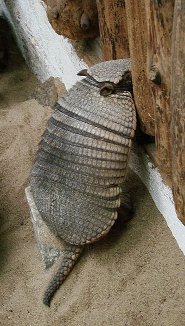
The
Large Hairy Armadillo (
Chaetophractus villosus) is the perfect name for this South American native, heavily armored around the body and head with thick bony plates. The difference from most other armadillos is a dense covering of long whitish or light brown hairs. These hairs cover his underparts and project from around the edges of his armor plating. It's Latin name, Chaetophractus Villosus, translates to "Hairy shell Hairy".
An adult weighs approximately two kilograms, or 4.4 pounds, with a snout to tail length varying from 31 cm (12.12 inches) to 57 cm (22.4 inches).
The Large Hairy Armadillo makes its home in Bolivia, Argentina,Chile, Paraguay, and Tierra del Fuego. They can be found from sea level to 1300 meters, in grasslands, savanna, forests, and farmland. Their species is widely distributed and highly adaptive. Some live close to human habitation, and indulge in "dumpster diving" meals, with maggots being a favorite treat.
Humans consider them pests, but also delicious. They are eaten and enjoyed quite extensively. Due to their heavy armor, the Large Hairy Armadillo's only serious predator is man. They are hunted for sport, food, or making musical instruments. They are often victims of road kill as well, due to their poor eyesight.
With their wide distribution and large population, these armadillos are considered to be of Least Concern on the Red List of the IUCN, the International Union of Conservation of Nature and Natural Resources. They are prolific breeders, reaching sexual maturity at an age of about nine months. Females commonly have three litters a year with two offspring. The Large Hairy Armadillo baby looks like a little piglet wearing soft leathery armor and it makes noises not unlike kitten mews.
Large Hairy Armadillos are powerful and fast diggers, due to the long sharp claws on their forefeet. They dig burrows, simple ones for temporary shelter, or complex burrows with branches that are used for living space and raising their young. They are usually nocturnal, but during the wintertime, some daylight activity is not unusual.
Except for
humans and their appetites, dogs, and cars, the Large Hairy Armadillo doesn't have such a bad life. They can be quite long-lived, reaching over twenty three years in captivity. Due to their adaptability and omnivorous diet, they have made a presence in large parts of South America.
Picture of the large hairy armadillo by Guérin Nicolas, licensed under
GFDL
You can help spreading the word about this animal by liking it on facebook
Permanent Link
Tuesday 26 February 2013
Bengal fox
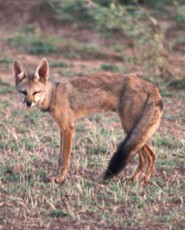
The
Bengal fox (
Vulpes bengalensis) is the species of fox most often found across the Indian subcontinent and Himalayan foothills, grayer, paler and smaller than its European cousins with the typically elongated muzzle, pointed ears and bushy tale. The Bengal fox typically weighs half of a
European fox's weight, between 2.3 to 4.1 kilograms (five to nine pounds;) from the tip of its now to the tip of its tail, it measures 70 to 90 centimeter (28 to 38 inches.)
Within its extensive range, the Bengal fox's preferred habitat is open grasslands or and scrub forest; it's never found in jungles, tall grasslands or steep hillsides. The Bengal fox's favourite time of day is dawn or twilight; it spends the hottest hours of the day hiding from the sun under thick vegetation or dozing in its multi-chambered tunnel.
The Bengal fox is not a pack animal; it's sparsely distributed across its preferred habitat and populations can fluctuate wildly according to the availability of its prey. They live as male/female dyads but generally prefer to hunt alone. Like most foxes, male and female Bengal foxes mate for life and the male and the female share responsibility for the cubs. Their breeding period lasts from December to January, and the males make loud vocalizations throughout the act.
Often the female will begin digging a new tunnel or excavating an old tunnel before she mates; the tunnel later becomes her cubs' first home. Females bear young once a year after a gestation period of a little over 50 days. Average litter size is two cubs but females can bear up to six cubs.
Bengal foxes are omnivores and opportunistic eaters; their diets mostly consist of
rodents,
reptiles, crabs, termites, insects, small
birds, and fruits.
The average lifespan of the Bengal fox is believed to be between 10 and 12 years in the wild. Its main predators are Asiatic wolves, feral dogs and -- man. As human populations expand and the species' preferred grassland habitat is repurposed for agricultural and industrial ends, the Bengal fox's habitat continues to shrink. While no specific conservation efforts have been targeted to the Bengal Fox, extinction is a possibility if its habitat continues to decline. Hunting of the animal is prohibited by the 1991 Indian Wildlife Protection Act, but the animal is occasionally hunted nonetheless since its teeth and tail are prized as folk medicine.
Picture of the bengal fox by A. T. Vanak, licensed under
GFDL
You can help spreading the word about this animal by liking it on facebook
Permanent Link
Monday 25 February 2013
Hartebeest - At Home on the African Range
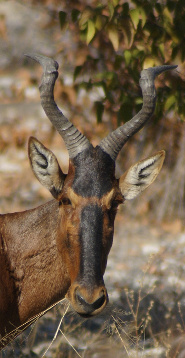 Hartebeests
Hartebeests (Alcelaphus buselaphus) are the African antelope. Had Dr. Brewster M. Higley, who wrote the poem "Home on the Range," visited Africa, the poem might well have said: "Home, home on the range, where the deer and the hartebeests roam." In 1876 when Dr. Higley penned the now famous poem, it ranged the entirety of Africa from Morocco and
Egypt in the north, to South Africa, Nambia, and Botswana in South. Now, due largely to the extinction of the Bubal Hartebeest that grazed the grasslands and forests of Northern Africa, hartebeests are no longer found in the north.
The word hartebeest is derived the Dutch word for deer, hertebeest. In general, they stand nearly 5 feet at the shoulder (1.5m) and weigh between 265-440 lbs. (120-200 kg). Their body style is more muscular than other antelope with high withers and sloping hindquarters. Their elongated head gives them a horsey countenance.
Both males and females have horns that can extend as long as 27 inches (70 cm).
The shape of the hartebeest's horns is one way to determine the specific subspecies. There are three basic horn patterns for the hartebeests:
• The U-shaped horns distinguish hartebeests that graze in the west African countries of Cambela, Nigeria, and Cameroon.
• The V-shaped horns are found on hartebeests in southern Africa.
• The inverted-bracket horn pattern are seen on hartebeests in Ethiopia, Sudan, and Somalia.
Hartebeests graze in medium and tall grass savannas and move about in herds. Female hartebeests form small groups to provide safety for their young. Male hartebeests move away from the herd and become more solitary as the reach sexual maturity. Whether alone or in herds, hartebeests keep a constant vigil for natural predators that include cheetahs, jackals, lions, hyenas, and leopards. In addition to natural predators, hartebeests are also hunted by humans for food and for sport.
There are many subspecies of hartebeests: Coke's, Jackson's, Red, Swayne's , Lelwel, Tora, and Bubal to name a few. Only one is extinct, the Bubal Hartebeest. The Bubal Hartebeests were once domesticated by the Egyptians as a food source. Horns from the Bubal Hartebeest found in the tombs at Abadiyeh give credence to the animal's importance to ancient Egyptian culture. Unfortunately, the Bubal Hartebeest was widely hunted, and the last Bubal Hartebeest died in 1923 in the Paris Zoo.
Picture of the red hartebeest by Hans Hillewaert, licensed under
Creative Commons Attribution-Share Alike 3.0 Unported license.
You can help spreading the word about this animal by liking it on facebook
Permanent Link
Friday 22 February 2013
Azara's Agouti - The Jungle's Gardeners
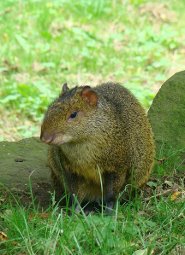
Measuring up to half a meter, or 20 inches, in length and weighing in at 3 kilograms, or 6.5lb, it is difficult to believe that
Azara's agoutis (
Dasyprocta azarae) are actually close relatives of mice and hamsters. However, it is absolutely true; they are members of the single largest mammalian order - the rodents.
Azara's agoutis are native to South America and are found in the rainforests of Argentina, Brazil and Paraguay. South America seems to be a veritable breeding ground for giant rodents, as the world's largest rodent, the capybara, is also found there. Even Azara's agouti is dwarfed by the 1.3 meter (4.3ft) long capybara.
The Azara's agouti's most prominent feature is perhaps its ears, which are large giving it good hearing, so that it can detect and evade predators. Its coloration aids it in this, with the speckled brown fur providing good
camouflage against the surrounding foliage. Interestingly, Azara's agoutis have five fingers, like us, on their hands but only three fingers on their feet. Retention of the extra fingers on the forelimb provides extra dexterity for the processing of food. When Azara's agoutis eat they hold food in their forepaws while resting on their hindlimbs.
Despite being active during the day, Azara's agoutis are notoriously difficult to study as they are naturally extremely shy and will flee when humans approach, perhaps letting out a little bark as a form of alarm call. Their shyness may be related to their solitary lifestyles but is also due to the fact that they are heavily preyed upon by many carnivorous species, including humans.
Azara's agoutis live in burrows or hollow tree trunks, which provide some protection from predators, particularly for mothers with young. Female Azara's agoutis gestate their young for ninety days, after which they give birth to up to 4 young per litter. In common with guinea pigs, but in contrast to mice, the young are precocial. This means they are relatively mature, with open eyes and a covering of fur, which aids temperature homeostasis.
Azara's agoutis are diurnal, that is to say they are active during the day, and they are herbivorous. Fascinatingly, they are thought to be only the only animal native to Brazil that can open a brazil nut. They are well adapted to this task with extremely sharp teeth and extraordinary strength. Azara's agoutis will also eat other nuts, fruit and seeds. This has earned them the name ‘jungle gardeners' because they spread seeds throughout the jungle aiding the dispersal of a plethora of plant species.
Perhaps the strangest thing about Azara's agouti is the name. This species is named after Felix de Azara (1742-1821). During his life he worked as a Spanish military officer, an engineer and a naturalist. The Azara's agouti is not the only species to be named after him; others include the Azara's ground mouse and Azara's spinetail. His work was held in high regard by the great Charles Darwin and an area of the moon is even named after him: Dorsum Azara.
Picture of the Azara's agouti by
Abujoy, licensed under
Creative Commons Attribution ShareAlike 2.5
You can help spreading the word about this animal by liking it on facebook
Permanent Link
Thursday 21 February 2013
The Gray Monk Saki - Fruit Thief and Nut Cracker

The
Gray monk saki (
Pithecia irrorata) is a
primate found in South America, primarily in the tropical rainforests of Brazil, Bolivia and Peru. Known for its thick muzzle, a bare face and a curly coat, this arboreal mammal has also been seen in forest patches and drier forests but rarely ventures beyond its home. Although dark in coloring, the Gray monk saki is actually named after the taxonomist who introduced the species in 1842.
Also known as the Bald-faced saki, this omnivorous primate subsists of seeds, leaves, and insects. The multi-layered lowland forests they inhabit promote year-round reproduction of nutrients and foliage, ensuring a constant availability of food. Gray monk sakis are well-known foragers of fruits which are heavily protected by hard casings, such as Brazil nuts. Unripe fruits are even preferred to ripe offerings. Sharp incisor teeth and large canines are used to cut through the shells and obtain the fruit pulp within. Active during the day, the small primate uses all four limbs as it moves through its habitat, leaping vertically from trees, staying within a forested area. A bushy non-prehensile tail, which may grow longer than its head and body combined, is not used for climbing.
Social animals able to interact with neighboring families yet still defend territory when necessary,
Pithecia irrorata live in clans. Formed groups can be as large as nine members, including one or two pairs of parents and their young. Monogamous mates communicate with each other by exchanging vocal sounds, employing different pitches to indicate danger or just basic social calls. Pregnancy may happen at any time, during any season. Females give birth to single offspring after a gestation cycle of 180 days, with a weaning period lasting about four months. There is no interbreeding among species of the genus Pithecia.
With a weight range of two and 6.6 pounds (3 kg), males weigh slightly more than their female breeding partners. Female faces have more hair however. The female’s frontal fur is also softer and heavier than a male’s coarse covering.
The Gray monk saki is considered a New World Monkey, with ancestry that dates back to Africa. As an arboreal creature living in trees, Pithecia irrorata do not have natural predators. Not endangered, the greatest threat to their existence is development and the presence of hunters, especially in Bolivia.
Picture of the gray monk saki by Ana Cotta, licensed under
Creative Commons Attribution 2.0 Generic license.
You can help spreading the word about this animal by liking it on facebook
Permanent Link
Tuesday 19 February 2013
The Hooded Warbler - A Striking Black And Yellow Fellow
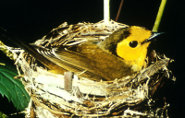
The
Hooded Warbler (
Wilsonia citrina) is a small migratory songbird endemic to eastern North America. It is most commonly found in the United States east of the Mississippi River, north to Rhode Island, and all along the Gulf Coast during the summer breeding season. Small Canadian populations exist in southern Ontario, and winter migration brings them farther south into Central America and a few Caribbean islands.
Adult Hooded Warblers of both sexes weigh about 9-12 grams (0.3-0.4 ounces) and are about 13 centimeters (5.1 inches) in length. Their underparts are yellow, while their wings, tail, and back are olive green in color. There is sometimes white spotting in the tail, and they have short black beaks. The male sports a solid black hood and bib around his bright yellow face that exhibits a striking contrast and gives the bird its name. Females may also display hoods of varying development, but often lack one completely.
In their breeding range, Hooded Warblers nest in mature forests of deciduous and mixed vegetation, southern cypress swamps, and ravines. The females prefers low-lying areas of underbrush and scrub in which to build their nests, which they make from plant material, bark, and dead leaves. They will lay 3 to 5 eggs between April and July, which will hatch after about 12 days of incubation, and within 9 days the chicks will have fledged.
Hooded Warblers of both sexes sing a short, shrill, patterned song to attract mates. Although a female may pair with one male during mating season, her eggs may end up being fertilized by a different male. Hooded Warblers are also very territorial, and a neighboring female will not move into a male's territory even if he is removed.
The Hooded Warbler's diet commonly includes small insects such as beetles, flies, and grasshoppers. It will also feed on moths and caterpillars, as well as spiders and other arthropods. Warblers themselves are often preyed upon by raccoons, cats, owls, and snakes, otherwise their normal lifespan is 8-9 years.
In the United States, Hooded Warblers are quite abundant throughout most of their range and increasing in some locations, although small populations in Wisconsin and Michigan are dwindling and of concern. Their numbers in
Canada are shrinking due to habitat loss and a decrease in mating pairs, and in Ontario they are listed as "threatened" and protected by the Endangered Species Act of 2007.
You can help spreading the word about this animal by liking it on facebook
Permanent Link
Monday 18 February 2013
Golden-Mantled Tamarin: The Mob
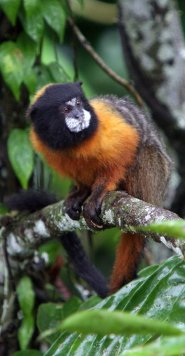
The golden-mantled tamarin (
Saguinus tripartitus) is a neotropical species that can be found between the Rio Curaray (
Ecuador) and the Rio Napo (
Peru). You may also find it east of the Andes mountains, as high as 400 meters above sea level.
It prefers lowland evergreen rainforests and lives in the trees. You rarely see it on the ground. It weighs between 290 to 420 g and its body is between 218 to 240 mm long. When you add the tail, it is between 316 and 341 mm long. Its face is white and its head is covered with black fur. Its tail is usually black on top and orange underneath. You will find a patch of cream-colored hair on its lower back.
The Golden-Mantled Tamarin lives is groups. Only the dominant female mates, and she will usually mate with several males. Usually, only two babies are born, and two or more males help care for the twins. The other females’ ovarian cycles are suppressed while they are living with a group. The average lifespan is only about six years.
These are social animals, and they have a defined social hierarchy while in a group of two to eight members. The Golden-Mantled Tamarin determines the social hierarchy by scent marking. Typically, there is an average of 13.5 animals per square kilometer. The species is listed as “near threatened” by the International Union for Conservation of Nature and Natural Resources. Its population has not been affected by humans yet, but because of the discovery of oil in their habitat, it is expected that the area will suffer high rates of deforestation, thus causing their population to decline by 25 percent over the next 18 years.
The Saguinus tripartitus eats insects, small vertebrates, flowers, nectar and fruit. If it senses or sees danger, it has a specific warning call, and the group may gang up on predators like a mob, though, if they can, they avoid areas frequented by their predators, usually birds of prey. It is also hunted by snakes,
tayras and
ocelots.
Picture of the Golden mantled tamarin by
lowjumpingfrog, licensed under the
Creative Commons Attribution 2.0 Generic license.
You can help spreading the word about this animal by liking it on facebook
Permanent Link
Thursday 14 February 2013
The Blue Poison Dart Frog - Pretty and Poisonous
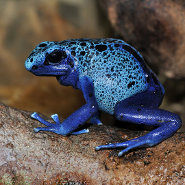
The blue poison dart frog (
Dendrobates azureus) flaunts its rich sapphire-blue coloring as a warning to predators that it will make a very unpleasant, possibly deadly meal. While poison dart frogs can be found in a number of different parts of Central and South America, this particular species occurs only in the southernmost area of
Suriname, near its border with
Brazil. This frog is also known as Okopipi, which is what the native Indians in Suriname call it.
The
Dendrobates family of frogs produces a toxin known as pumiliotoxin. Although a person might infer from this frog’s common name its toxins were used in the manufacturing of poisonous darts by native tribes, only the secretions of three other species of poison dart frogs were actually ever used in that manner, and
Dendrobates azureus was not one of them.
The blue poison dart frog is a striking-looking frog. Its upper body is a vivid sky blue that is liberally sprinkled with black and dark blue spots. Its four limbs and underside are a darker hue. Blue poison dart frogs typically weigh about 3 grams or approximately 0.11 ounces, and are typically 3 to 4.50 centimeters in length or 1.18 to 1.77 inches. It is believed that these amphibians can live up to between six to nine years in the wild.
The blue poison dart frog lives only in a few isolated rainforest islands that occur in Suriname’s otherwise dry Sipaliwini savannah area. This frog needs to live near a source of water, such as a stream. They are diurnal, meaning that they are active during the day, and are typically solitary, except during breeding season.
In the wild, these frogs feed on a variety of insects, including ants, spiders, termites and caterpillars; many of which contain toxic compounds. As the frog ingests its prey’s poisons, they are absorbed into its skin. Because of this reason, poison blue dart frogs raised in captivity and fed a diet of crickets and fruit flies do not produce toxins.
Unfortunately for the blue poison dart frog, being poisonous doesn’t mean that it can live a predator-free life. Some large spiders and snakes enjoy dining on these little amphibians. This frog is particularly vulnerable in its tadpole stage, where it may fall prey to snakes and dragonfly larvae.
Because this frog occurs in remote areas, its exact numbers are not known, but its IUCN status is vulnerable, and it is also currently listed as Appendix II of Cites, mainly due to its limited and unique habitat.
Picture of the blue poison dart frog by Quartl, licensed under the Creative Commons Attribution-Share Alike 3.0 Unported license.
You can help spreading the word about this animal by liking it on facebook
Permanent Link
Wednesday 13 February 2013
Northern Pika - The Whistle-Blowers of the Wild
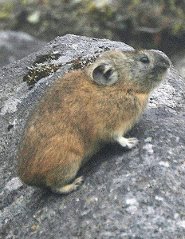 Northern Pika
Northern Pika (
Ochotona Hyperborea) are remarkable small burrowing animals that are quite similar to a
rabbit. They mainly inhabit the southern regions of Siberia, the northern regions of Mongolia, Manchuria, North Korea, and part of Russia and Japan. Commonly found throughout these areas, they are not endangered. Northern Pika prefer damp rain forest habitats that boast rocky formations, suitable for burrowing in and around fallen trees. Their bodies are around 127-186 mm (5-7 inches) long, plus a tail that is 50-120 mm (1-4inches) in length. They are covered in soft reddish-brown fur, and sport hind limbs that are shorter that their front limbs. Males and females resemble each other and can be difficult to tell apart.
Prior to World War II, they were best known for the value of their hide. They were trapped in large numbers for production of a fine felt. With the advent of newer and more economically sound materials, trapping and killing has ceased. Communication occurs by means of a distinct, high whistle that serves multiple purposes. This vocalization is common from males during breeding season, and in between mated pairs. A short and abrupt type of whistle is used to alert others to danger or if predators are spotted. The sound is so unique that it can be used to identify other specific individuals within a group. Their diet consists mostly of grasses, seeds, leaves, and other plant material. Food gathering consists of collecting varied types of vegetation and leaving it in the open to dry out. Once cured, it is then moved to a storage place, where it will accumulate into "hay piles". Mated pairs consume this store of food over the winter.
Northern Pika are also known to consume part of their own feces. It is thought that this is due to the highly digestible energy found in fecal material. During winter, they will dig tunnels into the snow to obtain fresh vegetation. They are a valuable link in the food chain and serve as prey to birds and other native carnivores. The foraging habit of storing supplies of food also provides substance for smaller herbivores, such as deer, who will poach their "hay piles".
You can help spreading the word about this animal by liking it on facebook
Permanent Link
Tuesday 12 February 2013
The White-Lipped Peccary - Nature's Aggressive Conservationist
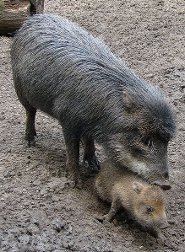
The
white-lipped peccary (
tayassu pecari), has gained a reputation in Central and South America as the most dangerous of the peccary species. The question should be asked, "Who is dangerous to whom?", because peccaries do not seek to be in contact with humans. People native to Central and South America still hunt peccaries for food, and people have already cleared away acres of rainforest in order to build competitive new industries or to feed cattle. White-lipped peccaries will stand their ground against anyone who gets too close to their territory. The White-lipped peccaries' preferred territory is within a rainforest, and since this territory has been rapidly shrinking, why shouldn't they defend it as aggressively as they can?
A white-lipped peccary is rather small to be such an aggressive animal. An adult peccary will stand from 40 to 60 centimeters at the shoulder (1.3 to 1.96 feet), with a body length between 90 and 130 centimeters (3 to 4.5 feet), and a weight from 25 to 40 kilograms (55 to 88 pounds). (Mayer,J.J., and R.M. Wetzel.1987. Tayassu pecari.mammalian species;293:1-7)) This animal does not have claws like a bear or a
puma. It uses its sharp tusks as a defense. Even with sharp tusks, a lone peccary would not have gained a reputation for aggression. White-lipped peccaries like to travel in large herds, and some of these herds can exceed 300 in number. If one individual within a herd is attacked, the entire herd will run to defend the injured individual.
The white-lipped peccary has a large range, from southeastern Mexico to northern Argentina, mostly in undisturbed rainforest. Its numbers have sharply declined in Central America and Mexico, and it is already considered extinct in El Salvador. Mike Boston and others in Costa Rica consider it to be a threatened species because of continued hunting.(Mike Boston-Osa Safari:The White-Lipped Peccary-in Osa Aventura)
The white-lipped peccary forms larger herds than any of the other peccary species that share some of its territory. These large herds, rarely smaller than 50 individuals, make it difficult to gain a consensus that the white-lipped species is endangered. These large herds can often be smelled before they are seen, since they have a skunk-like odor. A large herd of white-lipped peccaries can also be very noisy when threatened. They "bark" and they make chattering noises with their teeth. With their smell and noise and numbers, these peccaries can appear to be more of a threat to humans than humans are to them.
Much of the white-lipped peccary's former rainforest habitat has already disappeared, being replaced by industrialization and the preparation of grazing land for cattle. These relatively new land uses have threatened peccary populations far more than any group of hunters ever did. Hopefully, more people will learn to respect the warning barks of the white-lipped peccary, and let this guardian of the rainforest keep what is left of its territory.
Picture of the white-lipped peccary by
Chrumps, licensed under
GFDL
You can help spreading the word about this animal by liking it on facebook
Permanent Link
Monday 11 February 2013
The Amur Hedgehog - Nature's Solitary Pincushion
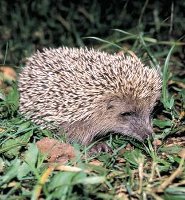
The
Amur Hedgehog (
Erinaceus Amurensis) is more commonly known as the Chinese Hedgehog. One of the fourteen different species of hedgehog that can be found in the world today, it is native to Amur Krai and Primorye in Russia, Manchuria in China, and the Korean Peninsula. The Amur Hedgehog is like any other hedgehog, They prefer tall grasses and undergrowth, such as under hedges and bushes. In the wild, their main diet consists of insects, worms, centipedes, snails, mice, frogs, and snakes. Hedgehogs in general were given the name because of the noise they make when foraging for food. Hedgehogs have very poor eyesight, so when foraging, they depend on their senses of smell and hearing rather than their eyesight. All that sniffing causes a pig-like grunt to be emitted, hence the name hedgehog.
Visibly, the Amur Hedgehog looks closest to the more common
Western European Hedgehog, though it tends to be a lot lighter in color. The average weight of an Amur Hedgehog is 600-1000 grams (1.3 to 2.2 pounds) and it's average length can be anywhere from 5.5 to 12 inches (14-30cm). It's tail is usually 1-2 inches (1-6 cm) in length. The entire body of the hedgehog is covered in short, smooth spines that are used as a deterrent for predators. If the hedgehog feels threatened, it will curl into a ball, leaving only it's sharp spines exposed. Definitely not a very appetizing prospect to any of the hedgehogs natural predators, such as birds of prey or wild canines. The hedgehog also sleeps in this position, usually in a cool, dark depression or hole. A common misconception is that the hedgehog is a burrowing mammal. They do like to sleep in a depression or hole, but most usually find an abandoned hole made by another animal. They are a very solitary animal. Most often, if two hedgehog come upon each other during their nightly foraging, they will just go their separate ways, though occasionally they will fight. The only time hedgehogs mix with other hedgehogs on purpose is during the mating season. At the end of the mating season, they go their different ways once again, the female hedgehog raising any young that may have been conceived. Hedgehogs can have a litter of hoglets ranging anywhere from 1 to 11 in size. The female is very protective of the hoglets, because the male hedgehog has been know to eat the young.
Picture of the Amur hedgehog from
http://lazovzap.ru
You can help spreading the word about this animal by liking it on facebook
Permanent Link
Friday 08 February 2013
Baird's tapir
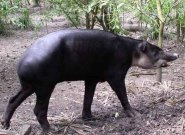
The
Baird's Tapir is a species of Tapir and is one of the three that is found in Central America, and is the largest land animal in Central America. Weighing in at an impressive 240-400 kilograms (525-880 lbs) the Tapir is a force to be reckoned with for any predator that might try to attack it (with the exception of man). Baird’s Tapir has a unique cream colored marking on its face and throat, while also have a darker spot on its cheeks. Its body has short black hair over a dark skin for added protection when it hides, if it hides; their legs are short and very powerful, allowing for the Tapir to run as fast as a human can when in the forest, and are well suited for moving through the brush and obstacles that they may encounter. It has a prehensile nose, and looks somewhat like a large boar; however the nose is reminiscent of an elephants (with a much shorter length). They have small tails that really don’t do much at all. Overall they are excellent swimmers and have been known to favor water and go diving to the bottom to search for soft plants when water is available to them. Their communication between distances is usually in the form of a kind of whistling call, and they can certainly pick up very faint sounds with excellent hearing.
The behavior of Baird’s Tapir is in line with its smaller cousins, as it prefers to forage for food, and it uses its specialized nose as a tool to gather up food and place it into the mouth, along with grasping leaves from trees it may otherwise be unable to reach. Gestation time (pregnancy) lasts for more than a year, usually extending to 390 days. Because they are such a large mammal they will usually only have one offspring per pregnancy, however in rare cases it as been observed that two have been born at the same time. The young tapir will stay with its mother for at least six months, and will usually stay as long as eight, by which time it has grown rapidly and reached a near adult size. When Baird’s Tapir is still young, or newborn, it has white stripes, spots, and is a bright reddish color.
Baird’s Tapir belongs to the genus Tapirus, which has three other species of Tapir. Tapirus belongs to the family Tapiridae, in which it is the only genus alive today. The family Tapiridae belongs to the order
Perissodactyla, which is all the odd toed ungulates, such as the horses and the rhinoceroses, and many other extinct species. Today, Baird’s Tapir is listed as endangered, and is currently under threat of extinction due to the actions of humans. Because of their long gestation time, a loss of a sing Baird’s Tapir becomes a problem, as that means one less Tapir to breed, and one more that will take more than a year to replace. Because of habitat loss they are isolated more and more from other populations, making genetic shallowing a real threat to the species’ survival. They are hunted and poached in spite of laws (which are not enforced most of the time) and their meat traded on the black market. Their numbers continue to decline as does their viable habitat and their ability to move around to other areas.
Interesting Facts about Baird’s Tapir:
- Baird’s Tapir is a very shy animal, and will run away rather than confront a human or perceived threat, unless harassed and cornered.
- When threatened or alarmed, the animal will let it be known by stamping a foot very hard against the ground as a method to ward off the threat and to defend itself.
- Their mouth is exceptionally powerful. There has been one documented incident in which a zookeeper was perceived as a threat by the animal, which then bit the zookeeper. It had such a powerful bite that it severed her arm.
Picture og the Baird's tapir by Sapphic, licensed under
GFDL
You can help spreading the word about this animal by liking it on facebook
Permanent Link
Thursday 07 February 2013
Nubian Ibex - The Resolute Combatant
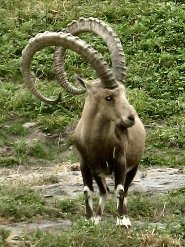
Previously, the
Nubian Ibex (
Capra nubiana) was known as Capra Ibex nubiana. One can easily recognize Nubian Ibex by its majestic backward-arching horns which are slender, long, and curve toward the outer side at the edge. Its beautiful horns cast a glorious silhouette against the striking rocky mountainous land of its habitat. Although both males and females have horns, males have much larger horns which grow up to 120 cm (48 inches) against 35 cm (14 inches) of females. Coat of the Nubian IbexCapra is light sandy brown in color. Its underbelly is white and its legs are marked with black and white dots. There is a dark strip running downwards on the back of the males and with age, they grow dark and develop a long beard. When the October rut starts, the color of the chest, neck, shoulders, upper legs, and sides turns dark brown which almost looks like black.
The Nubian Ibex is mainly found in Northern Parts of Africa and some parts of Arabia, Ethiopia, Egypt, Jordan, Israel, Saudi Arabia, Yemen, and Oman. Previously, it was also found in Syrian Arab Republic and Lebanon. This species dwells in the rocky deserts on the mountains where the weather is rough and dry at higher elevations which may rise up to 22,000 ft. During summers, the Nubian Ibex moves to mountainous regions to stay away from heat and in winters, it returns to the lower altitudes.
There can be 20 to 25 animals in one herd all of a single sex and their young ones roam with their maternal family till they are three years old. The mating in case of Nubian Ibex occurs in late summer, especially in October. The strongest male competes and fights with other males to get breeding rights by pushing other males with its horns. Gestation period lasts for around five months and in March, the young ones take birth. Normally, there is only one young one at a time but sometimes, the female may give birth to twins or even triplets; this, however is a very rare case. At the age of three, they reach their sexual maturity and this is the time to leave the herd. Average lifecycle of a Nubian Ibex can be up to 17 years.
This species has a tendency to remain most active during the daytime and rest at night. It is believed that its light colored, shiny coat reflects the solar radiation due to which it is able to remain active even during the hot summer days. It is a very alert animal and during daytime, it often maneuvers down steep and precipitous regions to graze leaves and grasses and later, returns to the rocky areas at night. It usually faces danger from such predators as eagles, bearded vultures, and
leopards. When threatened, it rises on its strong hind legs and faces the threat by pointing its powerful-looking horns at the predator.
Picture of the Nubian Ibex by
Stavenn, licensed under
GFDL.
You can help spreading the word about this animal by liking it on facebook
Permanent Link
Wednesday 06 February 2013
The Red Uakari - A Monkey On The Move
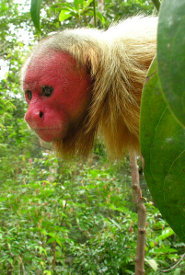
The
Red Uakari (
Cacajao calvus), with its bald head, crimson visage, wide eyes, short tail, and shaggy coat, probably looks like a monster to those fortunate enough to see one in the wild. In reality, this highly intelligent South American monkey is one of more than 1100 animals currently listed on the International Union for the Conservation of Nature and Natural Resources' Red List of Threatened Species.
Red Uakaries can be found in the jungles of Peru, Brazil, and Columbia, where they live in groups of 5 to 100 known as troops. Uakari troops don't just hang around all day, eating the insects, seeds, and fruits which make up their diet. Indeed, these highly social primates are also avid travelers, often covering as much as 4.8 kilometers (2.98 miles) per day. Uakaries are extremely agile creatures who can use their 15 cm (5.9 in) prehensile tails to hang from trees, and can jump as far as 20 meters (65 feet) from branch to branch.
The Red Uakari is a relatively small animal, reaching lengths of roughly 58 cm (23 in) and rarely weighing more than 4.1 kg (9 pounds). Despite its diminutive size, the animal's bright red face and thick coat of red or white fur give it an imposing look which may help frighten off indigenous predators like the ocelot, the boa constrictor, and the
harpy eagle. Many scientists believe the Red Uakari's distinctive appearance also helps other members of its troop spot it in the dense, shadowy foliage of the Amazonian jungle. Others theorize that their colorful faces serve as a sign of good health to attract potential mates, since wild animals suffering from malaria and other tropical diseases often have very pale skin.
The IUCN currently lists the Red Uakari as "vulnerable", due to hunting and loss of habitat. Over the past three decades, the number of Red Uakaries living in the wild has declined by nearly 30%. The good news is that the species' conservation status has actually improved over the last decade and a half. In 1994, the Red Uakari was listed as "endangered", meaning IUCN studies showed a high risk of extinction. In 2006, however, the Red Uakari was upgraded slightly to "threatened", indicating a likelihood of becoming endangered if conditions did not improve. The "vulnerable" classification was applied to the species in 2008.
Despite the ongoing efforts to protect the species which have resulted in these upgrades, the number of Red Uakaries living in the Amazon basin continues to decline. If stronger conservation measures are not enacted to protect its natural habitat, this colorful monkey may once again face extinction soon.
You can help spreading the word about this animal by liking it on facebook
Permanent Link
Monday 04 February 2013
Gaur - the tiger killer
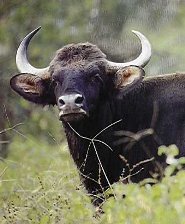
The
Gaur (
Bos frontalis) is a big relative of the cow, being a bovine itself, and is the largest known wild cattle on the planet – in fact they are bigger than
bison,
water buffalo, and the Cape buffalo. They are found in south Asia, and are particularly vulnerable. In fact, they are listed as a threatened species, and if more is not done to prevent their population loss, they will become endangered soon. They have a high ridge on their forehead between their horns and back has a ridge that is marked and raised with their body length being around 250 to 360cm (8-12 feet), and they typically stand as high as 220cm (7.2 feet) although the males typically are taller than females. They have big ears, smallish tails which average 70 to 100cm (28-40 inches), and a noted pattern of hair loss on their backs in males as they age. As adults they are very dark in color, being a dark brown to black – and darkening with age. Their heads from the eyes to the neck is an ashen gray and sometimes lighter, while their muzzle is a pale color. Their legs, from the knees down, are white. Adolescent and young Gaurs are usually lighter and paler in tone, and gradually darken with aging. Males typically weigh close to 1500kg, with a range of 1000-1500 being considered normal (2200 – 3300 lbs), while females being smaller and lighter weigh 700 to 1000 kg (1500-2200 lbs).
As they are the heaviest, and most powerful of all wild cattle, they hold a special place as the apex bovine, and their ecological role provides an important food source for only one large apex predator which is known to have killed a healthy adult – that being a tiger. Even then, there are more cases of tigers being killed by Gaurs, than Gaurs being killed by tigers. The males of the species are extremely muscular, and powerful – able to generate enough power to be deadly to predators, humans, and other domestic cattle that are unfortunate enough to provoke them. They live in herds of around 30-50 members, and they gestate for around 280 days. Herds are typically led by the oldest female, while males are mostly nomads that wander in search of females. In the herd the young are typically protected fiercely, as the large adult females will form a circle with heads and horns facing outward to protect the young from possible attack by tigers. An unusual behavior observed when a tiger was sensed by a herd, and they formed in an ancient human military tactic called a phalanx, and drove it off in a steady march toward the unfortunate tiger while lined up.
The Gaur’s Binomial Name is Bos gaurus, and there are four subspecies: Bos gaurus laosiensis which is found in Myanmar to China, Bos gaurus gaurus (seen in the picture) which is the type species that is found in India, Bos gaurus hubbacki which is found in Thailand and Malaysia and is the smallest, and finally Bos gaurus frontalis which is the domestic Gaur, and is likely a hybrid between cattle and Gaur. Gaur belong to the Genus Bos, of which all wild and domestic cattle belong. Bos belongs to the Subfamily Bovinae, which include the antelope, water buffalos, Voar, Saola, Bushback, and many more. Bovinae belongs to the Family Bovidae, of which all Bovines belong, including goats, impalas, chirus, gazelles, and many more. Bovidae belongs to the Infraorder Pecora which is most of the ruminants, such as
giraffes, deer, musk deer, and more. Pecora belongs to the Suborder of Ruminantia, of which all ruminants belong, which includes the mouse deer. Ruminantia belongs to the Order Artiodactyla, of which all the even toed ungulates belong. Artiodactyla belongs to Laurasiatheria, of which many mammals are members including
carnivores and
bats. This of course belongs to the Infraclass Eutheria, or all the placental mammals, and this belongs to the Subclass Theria, which is all the mammals with the exception of the
Monotremes.
Interesting Fact: The Gaur was cloned in 2001, and became the first cloned endangered species, unfortunately the healthy calf died due to unrelated causes (dysentery) two days later.
Picture is of the Indian Gaur, by
LRBurdak licensed under
GFDL
You can help spreading the word about this animal by liking it on facebook
Permanent Link
Friday 01 February 2013
Siberian Weasel - The Ubiquitous Asian Mustelid
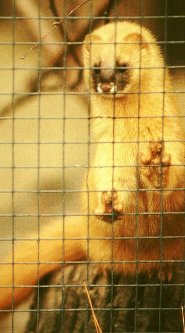
The
Siberian weasel (
Mustela sibirica), which is also referred to as the Yellow or Himalayan Weasel, is a relatively widespread animal indigenous to Asia. Due to the wide distribution and large population of the animal, they are classified as least concern for extinction.
The Siberian weasel has a long body and short legs but is huskier than their
stoat relatives. The head of the animal is elongated as well as narrow with the ears being broad yet short. The tail is quite long and consists of approximately half of the creature’s length in total. The adult male weasel is about 28 to 32 centimeters or 11 to 12.6 inches in length with the females ranging from 25 to 30.5 centimeters or 9.8 to 12 inches. The weight of the male ranges from 650 to 820 grams or 23 to 29 ounces with the females being significantly lighter, ranging from 360 to 430 grams or 13 to 15 ounces.
The winter coat of the animal is soft yet dense with the underfur being quite loose against the body. The weasel is completely monotone in coloration, typically being straw-red although the skin may have a pale peach or orange tone.
The Siberian weasel has an long rutting period that depends largely upon the location in which the animal lives. The rut typically begins during the early part of February and ends in late March in the Siberian regions. They mate for approximately 35 minutes and do so repeatedly. The gestation period of the animal can last anywhere from 38 to 41 days, with the litter averaging around 6 kits.
Unlike most animals, the weasel is not particular about where it makes it home. They have been found in rotted out stumps, tree roots, and may also become squatters in the abandoned homes of other animals. Along with their permanent home, the Siberian weasel has about five additional shelters which serve as more temporary housing.
The weasel preys predominantly on rodents who are smaller than they such as water voles, voles, and mice as well as chipmunks,
red squirrels, and
muskrats. The predators of the creature primarily consist of owls and other birds of prey.
These weasels can be found in many parts of Asia including Laos, northern Myanmar, Pakistan, North Korea, India, Bhutan, Nepal, Russia (particularly in Siberia and the northern parts of the country), the northern part of Thailand, and Taiwan.
You can help spreading the word about this animal by liking it on facebook
Permanent Link
 The Large Hairy Armadillo (Chaetophractus villosus) is the perfect name for this South American native, heavily armored around the body and head with thick bony plates. The difference from most other armadillos is a dense covering of long whitish or light brown hairs. These hairs cover his underparts and project from around the edges of his armor plating. It's Latin name, Chaetophractus Villosus, translates to "Hairy shell Hairy".
The Large Hairy Armadillo (Chaetophractus villosus) is the perfect name for this South American native, heavily armored around the body and head with thick bony plates. The difference from most other armadillos is a dense covering of long whitish or light brown hairs. These hairs cover his underparts and project from around the edges of his armor plating. It's Latin name, Chaetophractus Villosus, translates to "Hairy shell Hairy".
 The
The 
 Measuring up to half a meter, or 20 inches, in length and weighing in at 3 kilograms, or 6.5lb, it is difficult to believe that
Measuring up to half a meter, or 20 inches, in length and weighing in at 3 kilograms, or 6.5lb, it is difficult to believe that  The
The  The
The  The golden-mantled tamarin (Saguinus tripartitus) is a neotropical species that can be found between the Rio Curaray (
The golden-mantled tamarin (Saguinus tripartitus) is a neotropical species that can be found between the Rio Curaray ( The blue poison dart frog (Dendrobates azureus) flaunts its rich sapphire-blue coloring as a warning to predators that it will make a very unpleasant, possibly deadly meal. While poison dart frogs can be found in a number of different parts of Central and South America, this particular species occurs only in the southernmost area of
The blue poison dart frog (Dendrobates azureus) flaunts its rich sapphire-blue coloring as a warning to predators that it will make a very unpleasant, possibly deadly meal. While poison dart frogs can be found in a number of different parts of Central and South America, this particular species occurs only in the southernmost area of 
 The
The  The
The  The
The  Previously, the
Previously, the  The
The  The
The  The
The